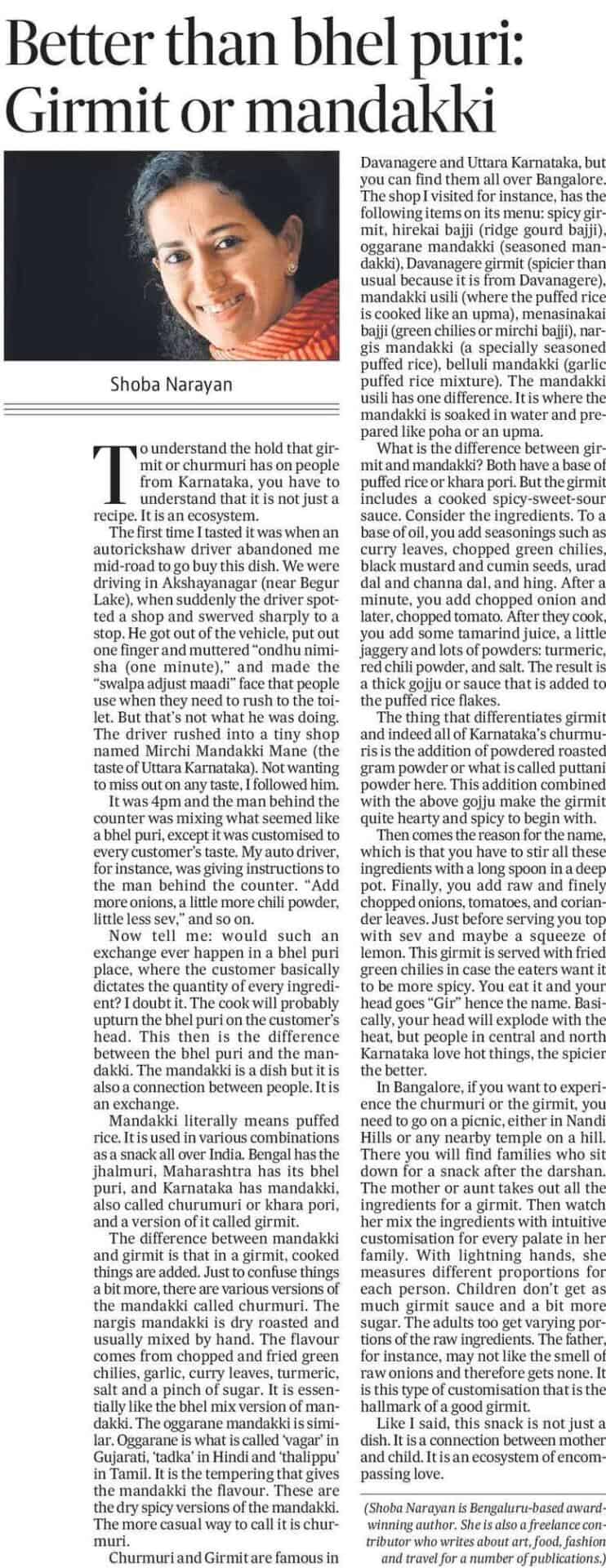To understand the hold that girmit or churmuri has on people from Karnataka, you have to understand that it is not just a recipe. It is an ecosystem.
The first time I tasted it was when an autorickshaw driver abandoned me mid-road to go buy this dish. We were driving in Akshayanagar (near Begur Lake), when suddenly the driver spotted a shop and swerved sharply to a stop. He got out of the vehicle, put out one finger and muttered “ondhu nimisha (one minute),” and made the “swalpa adjust maadi” face that people use when they need to rush to the toilet. But that’s not what he was doing. The driver rushed into a tiny shop named Mirchi Mandakki Mane (the taste of Uttara Karnataka). Not wanting to miss out on any taste, I followed him.
It was 4pm and the man behind the counter was mixing what seemed like a bhel puri, except it was customised to every customer’s taste. My auto driver, for instance, was giving instructions to the man behind the counter. “Add more onions, a little more chili powder, little less sev,” and so on.

Now tell me: would such an exchange ever happen in a bhel puri place, where the customer basically dictates the quantity of every ingredient? I doubt it. The cook will probably upturn the bhel puri on the customer’s head. This then is the difference between the bhel puri and the mandakki. The mandakki is a dish but it is also a connection between people. It is an exchange.
Mandakki literally means puffed rice. It is used in various combinations as a snack all over India. Bengal has the jhalmuri, Maharashtra has its bhel puri, and Karnataka has mandakki, also called churumuri or khara pori, and a version of it called girmit.
The difference between mandakki and girmit is that in a girmit, cooked things are added. Just to confuse things a bit more, there are various versions of the mandakki called churmuri. The nargis mandakki is dry roasted and usually mixed by hand. The flavour comes from chopped and fried green chilies, garlic, curry leaves, turmeric, salt and a pinch of sugar. It is essentially like the bhel mix version of mandakki. The oggarane mandakki is similar. Oggarane is what is called ‘vagar’ in Gujarati, ‘tadka’ in Hindi and ‘thalippu’ in Tamil. It is the tempering that gives the mandakki the flavour. These are the dry spicy versions of the mandakki. The more casual way to call it is churmuri.
Churmuri and Girmit are famous in Davanagere and Uttara Karnataka, but you can find them all over Bangalore. The shop I visited for instance, has the following items on its menu: spicy girmit, hirekai bajji (ridge gourd bajji), oggarane mandakki (seasoned mandakki), Davanagere girmit (spicier than usual because it is from Davanagere), mandakki usili (where the puffed rice is cooked like an upma), menasinakai bajji (green chilies or mirchi bajji), nargis mandakki (a specially seasoned puffed rice), belluli mandakki (garlic puffed rice mixture). The mandakki usili has one difference. It is where the mandakki is soaked in water and prepared like poha or an upma.
What is the difference between girmit and mandakki? Both have a base of puffed rice or khara pori. But the girmit includes a cooked spicy-sweet-sour sauce. Consider the ingredients. To a base of oil, you add seasonings such as curry leaves, chopped green chilies, black mustard and cumin seeds, urad dal and channa dal, and hing. After a minute, you add chopped onion and later, chopped tomato. After they cook, you add some tamarind juice, a little jaggery and lots of powders: turmeric, red chili powder, and salt. The result is a thick gojju or sauce that is added to the puffed rice flakes.
The thing that differentiates girmit and indeed all of Karnataka’s churmuris is the addition of powdered roasted gram powder or what is called puttani powder here. This addition combined with the above gojju make the girmit quite hearty and spicy to begin with.
Then comes the reason for the name, which is that you have to stir all these ingredients with a long spoon in a deep pot. Finally, you add raw and finely chopped onions, tomatoes, and coriander leaves. Just before serving you top with sev and maybe a squeeze of lemon. This girmit is served with fried green chilies in case the eaters want it to be more spicy. You eat it and your head goes “Gir” hence the name. Basically, your head will explode with the heat, but people in central and north Karnataka love hot things, the spicier the better.
In Bangalore, if you want to experience the churmuri or the girmit, you need to go on a picnic, either in Nandi Hills or any nearby temple on a hill. There you will find families who sit down for a snack after the darshan. The mother or aunt takes out all the ingredients for a girmit. Then watch her mix the ingredients with intuitive customisation for every palate in her family. With lightning hands, she measures different proportions for each person. Children don’t get as much girmit sauce and a bit more sugar. The adults too get varying portions of the raw ingredients. The father, for instance, may not like the smell of raw onions and therefore gets none. It is this type of customisation that is the hallmark of a good girmit.
(Shoba Narayan is Bengaluru-based award-winning author. She is also a freelance contributor who writes about art, food, fashion and travel for a number of publications.)




Leave A Comment